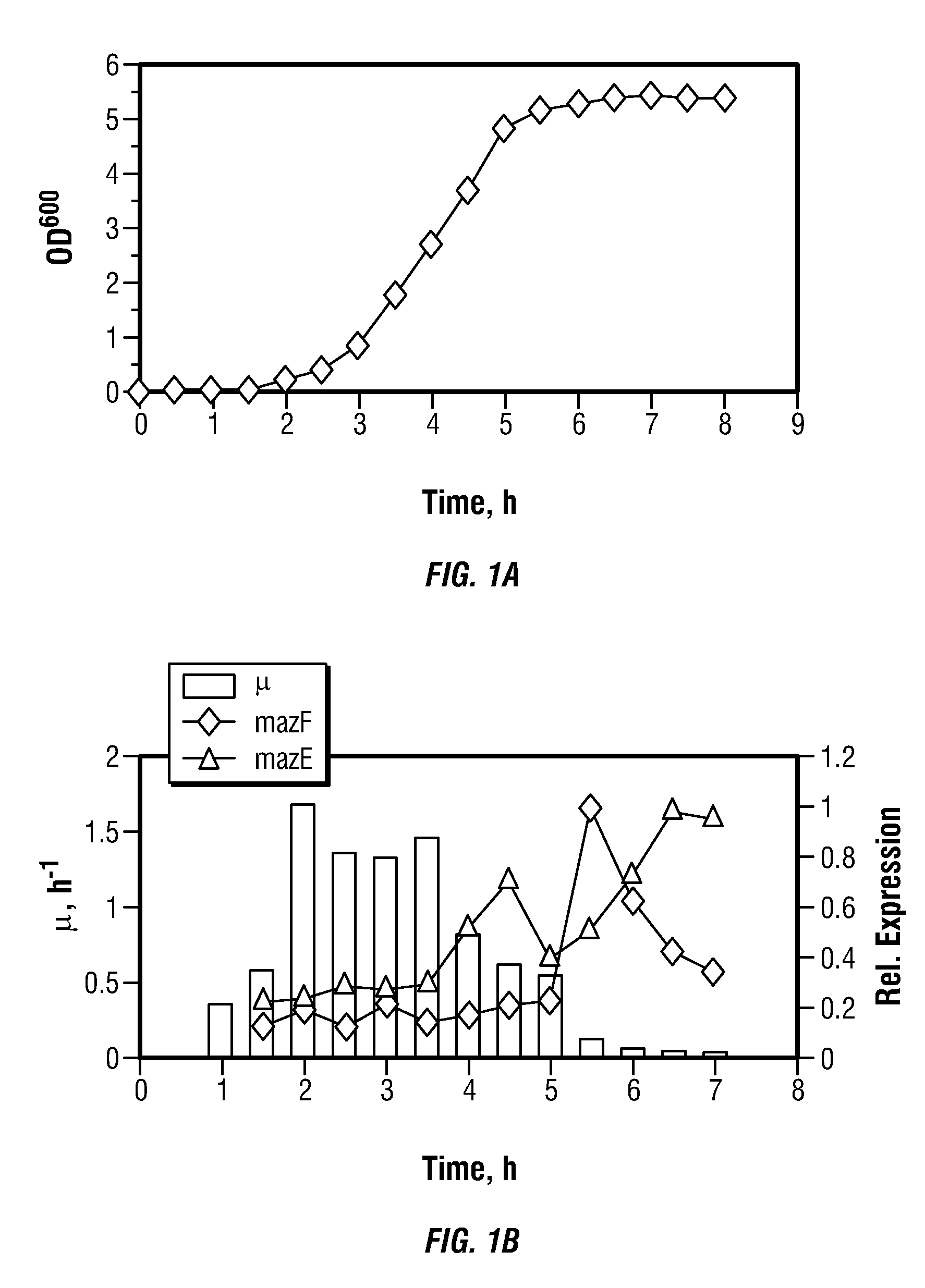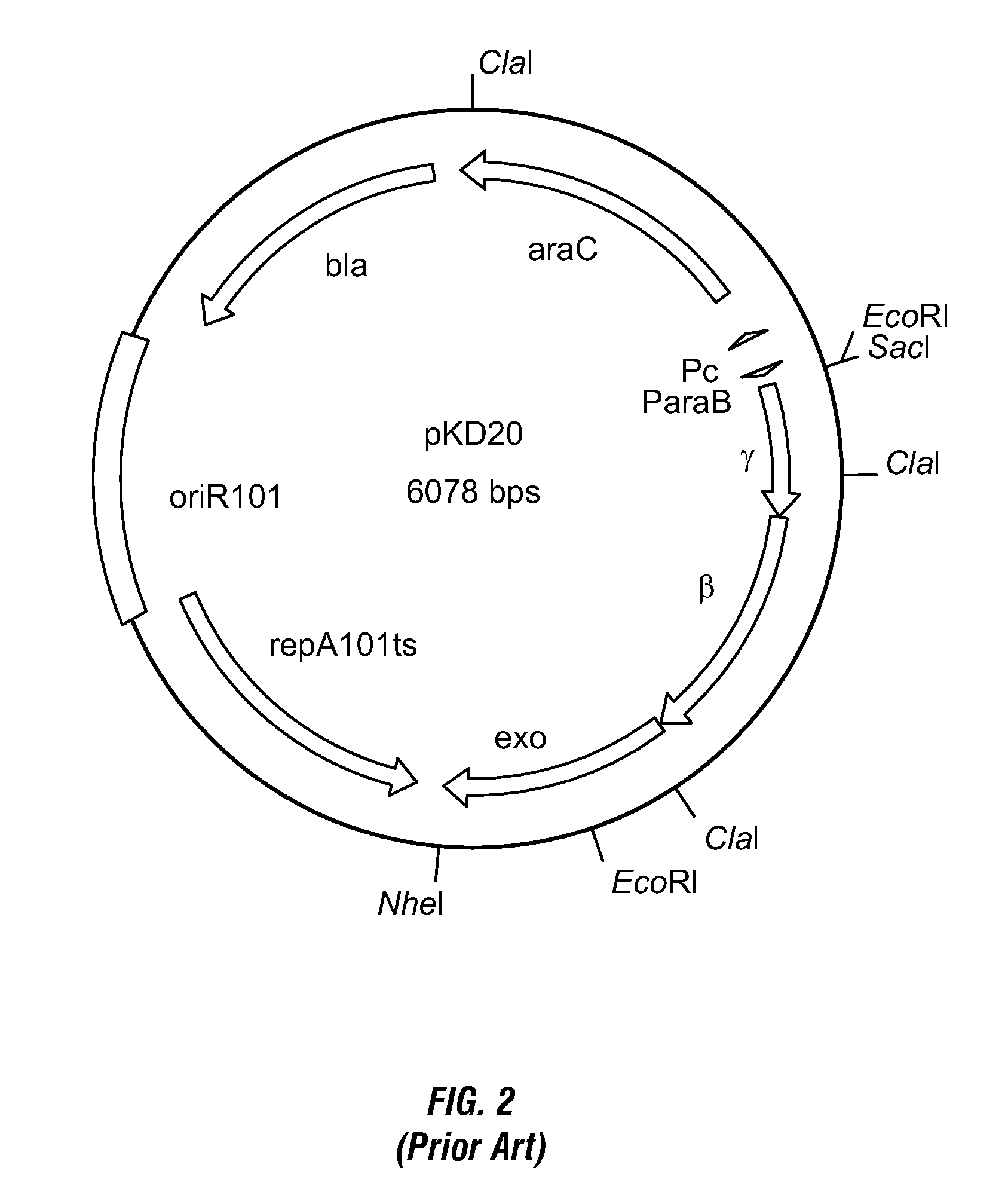Toxin/antitoxin systems and methods for regulating cellular growth, metabolic engineering and production of recombinant proteins
a technology of cellular growth and antitoxin, which is applied in the direction of animal/human proteins, bio chemistry apparatus and processes, etc., can solve the problems of inability to cultivate at low temperatures, inability to synthesis and cellular growth protein inhibition, and unstable antitoxin proteins
- Summary
- Abstract
- Description
- Claims
- Application Information
AI Technical Summary
Benefits of technology
Problems solved by technology
Method used
Image
Examples
example 1
Baseline Growth of E. coli Strain BL21 (Low Glucose)
[0081]The following example demonstrates use of exemplary compositions and methods of the invention for the regulation of cellular growth, synthesis of endogenous and / or heterologous proteins.
[0082]Several colonies of Escherichia coli strain BL21 grown on agarized LB medium at 37° C. were inoculated into 20 ml of M9 medium supplemented with 2 g / L glucose and incubated at 220 rpm, 37° C. overnight. 2 ml of the resulting culture was used as inoculation material to start batch fermentation in a laboratory-scale fermentor with a 2L working volume. The following chemically defined growth medium was used: glucose, 4 g / L; NH4Cl, 1.0 g / L; KH2PO4, 3.0 g / L; MgSO4.7H2O, 0.6 g / L; CaCl2, 0.01 g / L; FeSO4, 0.02 g / L; citric acid, 0.3 g / L; and trace metal solution, 1.9 ml / L. The trace metal solution contained: Al2(SO4)3.7H2O, 10 mg / L; CoCl2.6H2O, 8 mg / L; CuSO4.H2O, 2 mg / L; H3BO3, 1 mg / L; MnCl2.4H2O, 20 mg / L; NiCl2.6H2O, 1 mg / L; Na2MoO4.2H2O, 5 mg / L...
example 2
Baseline Growth of E. coli Strain BL21 (Medium Glucose)
[0085]In a related experiment, Escherichia coli strain BL21 was grown as a batch culture on the agarized LB medium under the growth conditions as described in Example 1, with the exception that the concentration of glucose in the medium was increased to 12 g / L.
[0086]The culture grew exponentially with a maximum growth rate (μmax) of 0.77 h−1. The growth stopped after about 9 hours. The final biomass concentration was 5.9 g(DCW) / L, which corresponds to a biomass yield of 0.49 g / g. Maximum acetate accumulation of 1.1 g / L was observed at about 8 hours of fermentation, after which it started to decrease.
example 3
Baseline Growth of E. coli Strain BL21 (High Glucose)
[0087]In another related experiment, Escherichia coli strain BL21 was grown as a batch culture on the agarized LB medium under the growth conditions as described in Example 1, with the exception that the concentration of glucose in the medium was increased to 24 g / L.
[0088]The culture grew exponentially with a maximum growth rate (μmax) of 0.65 h−1. The growth stopped after about 11 hours. The final biomass concentration was 10.3 g(DCW) / L which corresponds to a biomass yield of 0.43 g / g. Maximum acetate accumulation of 1.8 g / L was observed at about 10 hours of fermentation, after which it started to decrease.
[0089]Based on the results observed at the three different glucose concentrations, it is apparent the biomass yield decreases with increasing glucose concentration.
PUM
| Property | Measurement | Unit |
|---|---|---|
| volume | aaaaa | aaaaa |
| volume | aaaaa | aaaaa |
| temperature | aaaaa | aaaaa |
Abstract
Description
Claims
Application Information
 Login to View More
Login to View More - R&D
- Intellectual Property
- Life Sciences
- Materials
- Tech Scout
- Unparalleled Data Quality
- Higher Quality Content
- 60% Fewer Hallucinations
Browse by: Latest US Patents, China's latest patents, Technical Efficacy Thesaurus, Application Domain, Technology Topic, Popular Technical Reports.
© 2025 PatSnap. All rights reserved.Legal|Privacy policy|Modern Slavery Act Transparency Statement|Sitemap|About US| Contact US: help@patsnap.com



